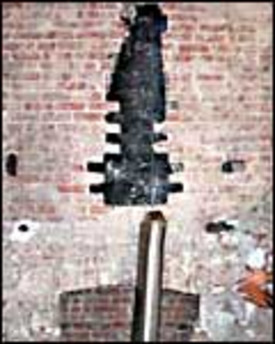 A winch is lowered down the flue and attached to the nose cone of the new flexible liner, which is pulled up through the flue and attached at the top of the chimney stack. |
A chimney can be a fire waiting to happen. Hidden by the brick exterior, most chimneys contain a clay or terracotta liner that makes up the innermost membrane of the chimney and helps contain smoke, carbon monoxide, and burning embers produced by the home’s fireplace or furnace. Some chimneys have no liner at all, just an aging brick shell.
Over time, the clay liner and brick can deteriorate, leaving the home vulnerable to carbon monoxide poisoning or fire. Harmful creosote, a flammable byproduct of burning wood, can build up on the inside of the chimney or liner and create the potential for chimney fires. Rebuilding the entire chimney liner is a one way to ensure a safer home, but it’s also the costliest, and requires extensive demolition to the existing brick. Chimney relining systems are a less costly and less invasive solution.
Stainless Steel
Today’s replacement chimney liners come in flexible or rigid form, and are commonly cylindrical in shape. These tubes are inserted into a home’s chimney, often within the existing flue, if one is present. Most liners are stainless steel alloy, although aluminum is used for low-efficiency gas furnaces. The alloy depends on the application, “wood-burning fireplaces and oil applications,” says Andrew Grover of Hallsted Welles Associates in New York City. Hallsted Welles deals with steel and traditional terracotta chimney relining systems. “Terracotta is a better established liner,” says Grover, “but it is much more labor intensive to install.” The time-tested terracotta liners can last 75 years, while stainless steel relining systems have only been around the better part of 25 years. “Stainless steel has less of a history,” added Grover, “but it’s cheaper to install.” A typical stainless steel liner runs from $20-40 per foot, but sturdier models will cost more.
Unique Installation
Installing a liner is not always a straightforward job. Old chimneys, multiple floors, and odd jogs within the chimney can make installing a rigid liner nearly impossible. Flexible liners are designed to deal with those challenges. Installation begins with clearing any obstructions within the flue. A probe is pulled up the chimney from above—this process is used to determine both the total length of the flue and to make sure that the liner will fit. A probe can also determine if there are any obstructions within the flue that will need clearing before the liner is installed. A thorough cleaning of the pre-existing flue is not always necessary as the new liner provides a clean, unobstructed pathway for smoke. It is best to install the widest liner possible—the wider the liner the better the draw or draft.
 |
||||
|
||||
While most replacement chimney liners are installed by pulling up from the top of the chimney, it is possible, but less common, to pull the liner down from below. To insert the liner, a winch is set at the top of the chimney and a line is spooled down the flue to meet the liner at the smoke chamber, which sits above the furnace or fireplace. A nose cone is fixed to the top of the liner, and the liner is winched up the chimney through the smoke chamber. “Sometimes the liner needs a little coaxing,” Grover says, “and you have to play with it, contort it a bit, to force it up the flue.” Once it is in place, a plate is screwed to the base of the liner, and the liner is sealed to the smoke chamber. The process may require a bit of masonry work or “smoke chamber renovation,” as Grover calls it, to achieve a perfect seal.
Once installed the liner should be insulated, a step that is often skipped, according to Grover. “Proper insulation will allow the liner to heat up properly, allowing for a good draft,” he says. It will also help contain a chimney fire, should one occur. Grover uses a vermiculite and concrete insulation mixture that is poured down the flue to fill the space between the liner and the flue and left to set. Another method of liner insulation is to wrap the liner in ceramic wool blanketing, but this option requires a smaller liner and may reduce the draft quality of the system.
A Job Best Left to the Pros
Although the installation of the liner itself may take only an hour of work, the renovations to the smoke chamber and insulation of the liner can take an additional day or two. While it is possible to do this project on your own, most chimney liner companies strongly recommend that homeowners hire a trained installer. Installing a chimney liner leaves no room for error, as any mistake can easily lead to fire.
Credit: Renovate Your World




























